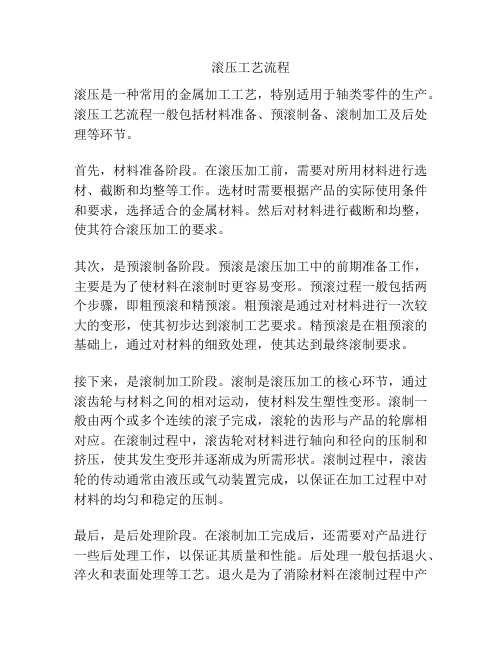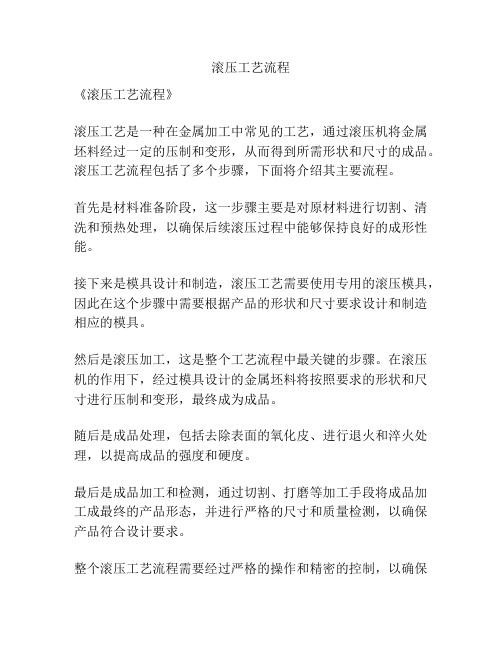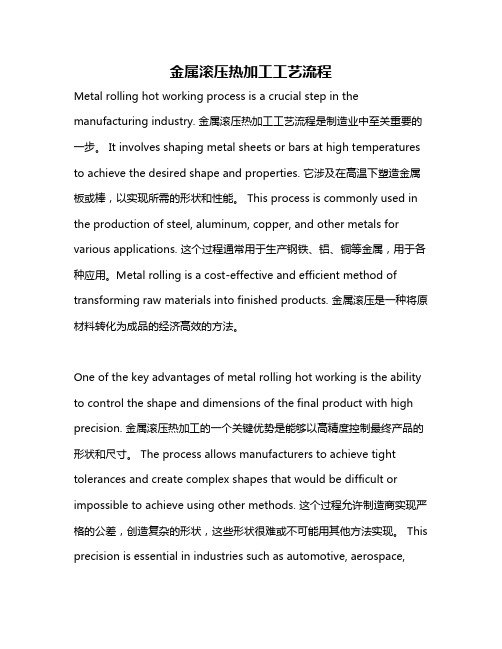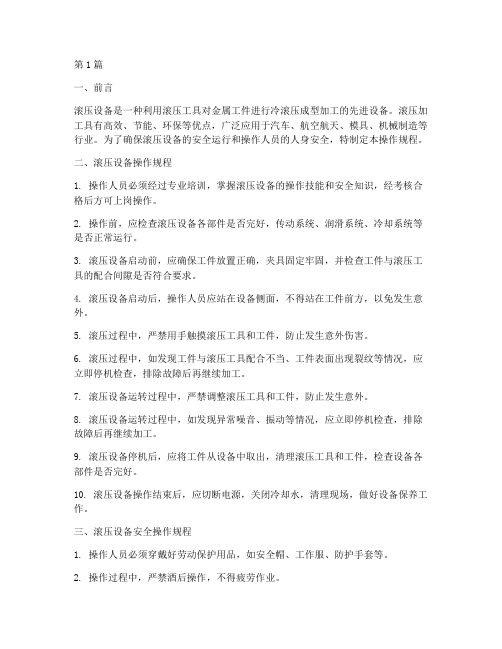金属滚压热加工工艺流程
滚压加工工艺

滚压加工工艺简介滚压加工工艺是一种常见的金属加工方法,通过滚压设备对金属材料进行形变加工,使其获得所需的形状和尺寸。
滚压加工技术广泛应用于汽车制造、航天航空、机械制造等领域。
本文将从滚压加工的原理、工艺流程、设备和应用等方面进行详细探讨。
原理滚压加工是通过在金属材料表面施加大压力,将其塑性变形至所需形状的一种加工方法。
滚压过程中,金属材料处于塑性变形的温度范围,使其分子间结构发生变化,从而改变材料的形状和尺寸。
滚压加工可以通过改变滚轮形状、滚轮排列方式和滚压力度等参数,对金属材料进行精确的控制,以获得满足要求的成品。
工艺流程滚压加工的主要工艺流程包括预处理、滚压加工和后处理三个步骤。
1. 预处理预处理是滚压加工的第一步,其目的是为了提高金属材料的可塑性,减少滚压过程中的应力和能量消耗。
预处理可以采用热处理、化学处理和机械处理等方法,使金属材料达到适合滚压加工的状态。
2. 滚压加工滚压加工是整个工艺的核心步骤,该步骤通过滚压设备对金属材料进行形变加工。
滚轮的形状和排列方式决定了金属材料的变形方式,滚压力度决定了加工的变形程度。
滚压过程中需要对滚轮、工件和润滑液进行充分的冷却和润滑,以降低摩擦和热量的产生,提高加工效果和生产效率。
后处理是滚压加工的最后一步,其目的是对加工后的成品进行整形、调整和修整。
后处理可以采用热处理、机械加工和表面处理等方法,使成品达到所需的精度、表面光洁度和机械性能要求。
设备滚压加工依靠专用的滚压设备进行实施,主要包括滚轮、滚床和润滑系统等组成部分。
1. 滚轮滚轮是滚压设备的核心部件,其形状和排列方式直接决定了加工成品的形状和尺寸。
滚轮可以分为单排滚轮、双排滚轮和多排滚轮等不同形式,根据加工要求选择合适的滚轮类型。
2. 滚床滚床是用于支撑和定位金属材料的装置,保证滚轮对工件的加工精度和一致性。
滚床的结构和刀具的改变,可以实现对不同形状和尺寸的工件进行滚压加工。
3. 润滑系统润滑系统主要用于降低滚压过程中的摩擦和热量产生,提高加工效果和生产效率。
金属板材加工件热压

金属板材加工件热压技术是近年来比较流行的一种工艺,其主要应用于金属材料的加工和处理。
相比于其他加工方法,热压技术具有加工成型精度高、加工速度快、加工效率高和加工工艺简单等优点。
一、热压加工原理热压加工原理是指在高温下将待加工的金属材料置于模具中,施加压力使其变形并完成成型。
在加工过程中,热压工艺会将金属材料加热至其塑性区,通过成型模具对其施加压力,使其成型并保持一定的尺寸和形状。
二、热压加工工艺热压加工工艺包括四个步骤:材料准备、模具制备、加热和压力加工。
材料准备:材料是热压加工的关键因素,不同材料要求不同的加工工艺。
在热压加工之前,需要将待加工的材料加工成适应模具形状和尺寸的板材。
模具制备:模具是热压加工的关键,它决定了成型的精度和形状。
模具可以根据需要定制,但制作模具的成本较高。
加热:加热是热压加工中的一项重要过程。
加热温度应该高于材料的熔点,根据材料的性质和所需的成形效果,加热温度也不同。
压力加工:压力是热压加工中的最后一个阶段。
一旦加热并达到所需的温度后,将在模具中施加所需的压力,使材料达到所需的形状和尺寸。
三、热压加工的应用技术已经广泛应用于航空航天、汽车、机械制造等领域。
其中最大的应用是航空航天领域,热压加工技术通常用于生产航空发动机叶片、引擎外壳、发动机零部件等。
此外,热压加工技术还被广泛应用于自行车、摩托车、汽车等车辆的生产中。
四、热压加工的优点热压加工技术在近年来得到了广泛的应用,主要是因为其具有一下几个优点:1. 成品精度高:热压加工技术可以制造出高精度的零部件,其成型精度更高,重复性更好。
2. 加工速度快:相比其他加工方法,热压加工速度更快,从而可以大幅度提高生产效率。
3. 生产成本较低:由于热压加工使用的材料是金属板材,在生产成本方面与其他材料相比具有一定的优势。
4. 生产工艺简单:热压加工技术非常简单,无需太多的设备和材料,因此生产工艺也更加简单,生产成本更低。
总结:热压加工技术是一种趋向完善的新兴技术,其在金属材料、汽车、航空航天等领域应用广泛。
滚压工艺流程

滚压工艺流程滚压是一种常用的金属加工工艺,特别适用于轴类零件的生产。
滚压工艺流程一般包括材料准备、预滚制备、滚制加工及后处理等环节。
首先,材料准备阶段。
在滚压加工前,需要对所用材料进行选材、截断和均整等工作。
选材时需要根据产品的实际使用条件和要求,选择适合的金属材料。
然后对材料进行截断和均整,使其符合滚压加工的要求。
其次,是预滚制备阶段。
预滚是滚压加工中的前期准备工作,主要是为了使材料在滚制时更容易变形。
预滚过程一般包括两个步骤,即粗预滚和精预滚。
粗预滚是通过对材料进行一次较大的变形,使其初步达到滚制工艺要求。
精预滚是在粗预滚的基础上,通过对材料的细致处理,使其达到最终滚制要求。
接下来,是滚制加工阶段。
滚制是滚压加工的核心环节,通过滚齿轮与材料之间的相对运动,使材料发生塑性变形。
滚制一般由两个或多个连续的滚子完成,滚轮的齿形与产品的轮廓相对应。
在滚制过程中,滚齿轮对材料进行轴向和径向的压制和挤压,使其发生变形并逐渐成为所需形状。
滚制过程中,滚齿轮的传动通常由液压或气动装置完成,以保证在加工过程中对材料的均匀和稳定的压制。
最后,是后处理阶段。
在滚制加工完成后,还需要对产品进行一些后处理工作,以保证其质量和性能。
后处理一般包括退火、淬火和表面处理等工艺。
退火是为了消除材料在滚制过程中产生的应力和变形,提高产品的力学性能。
淬火是为了提高产品的硬度和强度,同时增加其耐磨和耐腐蚀性能。
表面处理可以采用镀锌、镀铬、喷涂等方法,以提高产品的外观和耐用性。
总之,滚压工艺流程包括材料准备、预滚制备、滚制加工及后处理等多个环节。
每个环节都对产品的质量和性能有着重要影响,需要经过精细的设计和操作,才能得到满足要求的产品。
滚压工艺的应用广泛,不仅可以用于生产轴类零件,还可以在汽车、机械、航空航天等领域得到广泛应用,为各行各业的发展提供重要的支撑。
滚压工艺流程

滚压工艺流程
《滚压工艺流程》
滚压工艺是一种在金属加工中常见的工艺,通过滚压机将金属坯料经过一定的压制和变形,从而得到所需形状和尺寸的成品。
滚压工艺流程包括了多个步骤,下面将介绍其主要流程。
首先是材料准备阶段,这一步骤主要是对原材料进行切割、清洗和预热处理,以确保后续滚压过程中能够保持良好的成形性能。
接下来是模具设计和制造,滚压工艺需要使用专用的滚压模具,因此在这个步骤中需要根据产品的形状和尺寸要求设计和制造相应的模具。
然后是滚压加工,这是整个工艺流程中最关键的步骤。
在滚压机的作用下,经过模具设计的金属坯料将按照要求的形状和尺寸进行压制和变形,最终成为成品。
随后是成品处理,包括去除表面的氧化皮、进行退火和淬火处理,以提高成品的强度和硬度。
最后是成品加工和检测,通过切割、打磨等加工手段将成品加工成最终的产品形态,并进行严格的尺寸和质量检测,以确保产品符合设计要求。
整个滚压工艺流程需要经过严格的操作和精密的控制,以确保
成品能够满足客户的需求。
而滚压工艺也因其高效、成本低、生产速度快等优势,受到了广泛的应用和欢迎。
金属滚压热加工工艺流程

金属滚压热加工工艺流程英文回答:Metal rolling is a hot working process used to shape metal into desired forms and dimensions. It involves passing a metal billet or ingot through a pair of rotating rolls to reduce its thickness and increase its length. This process is commonly used in the manufacturing of steel sheets, plates, and bars.The metal rolling process can be divided into several stages: preheating, rolling, and post-rolling operations. In the preheating stage, the metal is heated to a specific temperature to improve its plasticity and reduce the force required for rolling. This is usually done in a furnace or through induction heating.Once the metal is heated, it is fed between the rolls, which exert pressure on the metal and cause it to deform. The rolls rotate in opposite directions, pulling the metalthrough and reducing its thickness. This is known as the rolling stage.After the metal has been rolled, it may undergo additional post-rolling operations such as annealing, quenching, or tempering. These processes are used to improve the mechanical properties of the metal and relieve any residual stresses.Metal rolling offers several advantages over other forming processes. Firstly, it allows for the production of large quantities of metal products with consistent dimensions and quality. Secondly, it can be used to produce complex shapes and profiles that are difficult to achieve through other methods. Lastly, it can improve the mechanical properties of the metal, such as strength and toughness.Metal rolling is widely used in various industries, including automotive, construction, and aerospace. For example, in the automotive industry, metal rolling is used to produce steel sheets that are used for car body panels.In the construction industry, it is used to manufacture steel beams and columns. In the aerospace industry, it is used to produce aluminum sheets for aircraft components.In conclusion, metal rolling is a hot working process that is used to shape metal into desired forms and dimensions. It involves several stages, including preheating, rolling, and post-rolling operations. Metal rolling offers several advantages and is widely used in various industries.中文回答:金属滚压是一种热加工工艺,用于将金属塑造成所需的形状和尺寸。
金属板材的滚压成型

金属板材的滚压成型来源:中数休闲发表时间:2008-11-19 浏览次数:298【字体:大中小】1 板料滚压成型的功能及用途板料滚压成型通用于等断面制件的大批量生产。
由于使用多对辊轮的连续成型,可以滚制出许多壁薄、质轻、刚度大而且断面形状复杂的制件型材(如图1所示)。
加上顺序滚压过程中可以与冲洗、起状、卷筒、焊接等多种工艺装置连动,形成流水作业,故生产效率极高,成本低廉,是现代加工制品中广泛应用和大力推广的特种工艺加工方法。
如自行车钢圈的生产,自来水管的生产,塑料龙骨的生产,波汶板的生产以及国外广为应用的不锈钢窗框的生产。
2滚压成型的原理与设计要点滚压成型原理如图2所示,是由多对成型辊轮顺次对板料变形并向前送进的滚压成型。
成型在工艺上与弯曲工序极为相似,其设计要点主要有:2.1断面的展开长度和弯曲展开一样,要考虑中性层的移动。
2.2在弯曲半径很小时,要考虑到拉伸给截面宽度的增加。
2.3以轮廓外形所制定的轴线在各工步中保持一致。
2.4每对辊轮对型材壁的弯曲角度有所限制,否则将产生滚压不畅(卡壳)、制品不光滑,起皱现象。
弯曲数据如下:板材厚δ<1mm 弯曲角:30°~40°板材厚δ=1~2.5mm 弯曲角:30°~40°板材厚δ>1.5 mm 弯曲角:30°~40°塑性好的材料取上限,塑性差的材料取下限。
连续弯曲要考虑金属的加工硬化。
2.5起始变形时,竖壁弯曲和底部弯曲不能同时进行。
2.6最后一对成型辊轮形状应考虑弹性回跳数据。
在滚压成型中,目前理论尚不完整,以实践经验和类比推断为主,在金属板材变形机理上展开。
3.1制件花型展开图开始设计时,首先考虑断面形状。
以制件的弯曲过程逐渐展开,直至回复到平直板料的连续图形,就称之为花型展开图,如图3所示。
将展开过程的形状,叠放在同一张纸上的花型展开图进行分析研究、无论对形状简单还是复杂的断面都是十分有效的,进而可以从整体上考虑从一个辊轮孔型移至下一个辊轮孔型的时候,高度、宽度方向和弯曲加工有无不合理的地方。
金属材料热处理工艺流程

金属材料热处理工艺流程金属材料热处理工艺流程是通过将金属材料加热至一定温度,保持一段时间后进行冷却,以改变金属材料的组织结构和性能的一种工艺。
它可以改变金属材料的硬度、强度、韧性、耐磨性等性能,提高金属材料的使用寿命和适应性。
下面是一篇关于金属材料热处理工艺流程的具体介绍。
首先,对于金属材料的热处理工艺流程的选择,需要根据具体的材料类型和要求进行判断。
一般来说,常见的金属材料热处理工艺流程包括退火、正火、淬火、回火等。
退火是将金属材料加热到一定温度,然后缓慢冷却,以减弱金属材料的内应力,改善材料的可加工性和机械性能。
退火的温度和冷却速率需要根据具体的材料来确定。
正火是将金属材料加热到适当的温度,然后进行适当的保温时间,最后以适当速率冷却,以获得所需的组织和性能。
正火可以提高金属材料的硬度和强度。
淬火是将金属材料加热到适当的温度,然后迅速冷却,使金属材料迅速固化。
淬火可以使金属材料获得高硬度和高强度,但也会造成材料脆性增加。
因此,淬火后一般需要进行回火处理。
回火是将淬火后的金属材料加热到适当的温度,然后进行适当的保温时间,最后冷却。
回火可以减轻淬火后金属材料的脆性,提高其韧性和抗冲击性能。
具体的金属材料热处理工艺流程如下:1. 金属材料的准备:需要对原材料进行切割、锯切或裁剪,以得到所需形状和尺寸的工件。
2. 加热:将金属工件放入炉中,进行加热。
加热的温度和时间需要根据具体的材料和要求来确定。
3. 保温:将金属工件在加热温度下保持一段时间,以达到所需的组织和性能。
4. 冷却:根据具体的要求,选择合适的冷却速率和方法对金属工件进行冷却。
一般来说,可以选择空冷、水冷、油冷等不同的冷却方式。
5. 检测:对热处理后的金属材料进行检测,包括金相检查、硬度检测、力学性能测试等。
6. 处理:根据检测结果对金属材料进行必要的修整和处理,以满足使用要求。
以上是金属材料热处理工艺流程的一般步骤。
在实际应用中,需要根据具体材料和要求进行相应的调整和改进。
机械制造中的重要工艺金属热处理,热处理的工艺过程详细讲解

机械制造中的重要工艺金属热处理,热处理的工艺过程详细讲解金属热处理是机械制造中的重要工艺之一,与其他加工工艺相比,热处理一般不改变工件的形状和整体的化学成分,而是通过改变工件内部的显微组织,或改变工件表面的化学成分,赋予或改善工件的使用性能。
其特点是改善工件的内在质量,而这一般不是肉眼所能看到的。
正如有些人说,机械加工是外科,热处理就是内科,代表一个国家制造业的核心竞争力。
工艺过程热处理工艺一般包括加热、保温、冷却三个过程,有时只有加热和冷却两个过程。
这些过程互相衔接,不可间断。
金属加热时,工件暴露在空气中,常常发生氧化、脱碳(即钢铁零件表面碳含量降低),这对于热处理后零件的表面性能有很不利的影响。
因而金属通常应在可控气氛或保护气氛中、熔融盐中和真空中加热,也可用涂料或包装方法进行保护加热。
加热温度是热处理工艺的重要工艺参数之一,选择和控制加热温度,是保证热处理质量的主要问题。
加热温度随被处理的金属材料和热处理的目的不同而异,但一般都是加热到相变温度以上,以获得高温组织。
另外转变需要一定的时间,因此当金属工件表面达到要求的加热温度时,还须在此温度保持一定时间,使内外温度一致,使显微组织转变完全,这段时间称为保温时间。
(保温)采用高能密度加热和表面热处理时,加热速度极快,一般就没有保温时间,而化学热处理的保温时间往往较长。
冷却液是热处理工艺过程中不可缺少的步骤,冷却方法因工艺不同而不同,主要是控制冷却速度。
工艺分类金属热处理工艺大体可分为整体热处理、表面热处理和化学热处理三大类。
根据加热介质、加热温度和冷却方法的不同,每一大类又可区分为若干不同的热处理工艺。
同一种金属采用不同的热处理工艺,可获得不同的组织,从而具有不同的性能。
钢铁是工业上应用最广的金属,而且钢铁显微组织也最为复杂,因此钢铁热处理工艺种类繁多。
整体热处理是对工件整体加热,然后以适当的速度冷却,获得需要的金相组织,以改变其整体力学性能的金属热处理工艺。
金属材料热处理工艺(附详细工序及操作手法)

金属材料热处理工艺(附详细工序及操作手法)“ 培养一批能真正懂得设计精髓、理论结合实际的机械工程师。
”——正达教育荣誉出品一、热处理的定义热处理是指金属在固态下经加热、保温和冷却,以改变金属的内部组织和结构,从而获得所需性能的一种工艺过程。
热处理的三大要素①加热( Heating)目的是获得均匀细小的奥氏体组织。
②保温(Holding)目的是保证工件烧透,并防止脱碳和氧化等。
③冷却(Cooling)目的是使奥氏体转变为不同的组织。
热处理后的组织加热、保温后的奥氏体在随后的冷却过程中,根据冷却速度的不同将转变成不同的组织。
不同的组织具有不同的性能。
二、热处理工艺1.退火操作方法:将钢件加热到Ac3+30~50度或Ac1+30~50度或Ac1以下的温度(可以查阅有关资料)后,一般随炉温缓慢冷却。
目的:1.降低硬度,提高塑性,改善切削加工与压力加工性能;2.细化晶粒,改善力学性能,为下一步工序做准备;3.消除冷、热加工所产生的内应力。
应用要点:1.适用于合金结构钢、碳素工具钢、合金工具钢、高速钢的锻件、焊接件以及供应状态不合格的原材料;2.一般在毛坯状态进行退火。
2.正火操作方法:将钢件加热到Ac3或Accm 以上30~50度,保温后以稍大于退火的冷却速度冷却。
目的:1.降低硬度,提高塑性,改善切削加工与压力加工性能;2.细化晶粒,改善力学性能,为下一步工序做准备;3.消除冷、热加工所产生的内应力。
应用要点:正火通常作为锻件、焊接件以及渗碳零件的预先热处理工序。
对于性能要求不高的低碳的和中碳的碳素结构钢及低合金钢件,也可作为最后热处理。
对于一般中、高合金钢,空冷可导致完全或局部淬火,因此不能作为最后热处理工序。
3.淬火操作方法:将钢件加热到相变温度Ac3或Ac1以上,保温一段时间,然后在水、硝盐、油、或空气中快速冷却。
目的:淬火一般是为了得到高硬度的马氏体组织,有时对某些高合金钢(如不锈钢、耐磨钢)淬火时,则是为了得到单一均匀的奥氏体组织,以提高耐磨性和耐蚀性。
金属塑性加工方法——滚压(一)

金属塑性加工方法——滚压(一)简介滚压是一种常用的金属塑性加工方法,通过在金属工件上施加压力,将其通过滚动运动的方式使其形状发生变化。
本文将介绍滚压的基本原理、工艺流程和应用领域。
滚压原理滚压是一种通过挤压金属工件来改变其形状的加工方法。
它利用滚轮施加在金属工件上的压力,将其挤压成所需的形状。
滚压通常使用辊和工件之间的滚动运动来实现,这样可以减少工件与滚轮之间的摩擦,并且更容易控制加工过程中的变形。
滚压可以适用于各种金属材料,包括钢铁、铝合金等,广泛应用于制造业中。
滚压工艺流程滚压的工艺流程通常包括以下几个步骤:1. 准备工作:选择适当的滚轮、加工设备和工件材料,并确保它们的表面光洁度和几何尺寸的精度。
2. 装夹工件:将工件固定在滚压机床上,确保工件与滚轮之间的接触面积足够,并调整滚轮的位置和角度。
3. 加工过程:通过滚压机床施加压力,使滚轮与工件产生相对滚动运动,逐渐将工件挤压成所需形状。
4. 检测和调整:在加工过程中,及时检测工件的形状和尺寸,根据需要进行调整和修正。
5. 完成加工:当工件达到要求的形状和尺寸后,完成滚压加工,并进行后续的处理,如退火等。
滚压的应用领域滚压作为一种重要的金属塑性加工方法,在各个制造领域都得到了广泛应用。
以下是一些常见的滚压应用领域:1. 轧钢厂:在钢铁工业中,滚压被用于生产各种形状和尺寸的钢材,如槽钢、工字钢等。
2. 汽车制造:滚压被广泛应用于汽车制造过程中,用于生产车身零部件、发动机零件等。
3. 金属管道加工:滚压在金属管道加工中是一种常用的方法,用于改变管道的形状和尺寸。
4. 航空航天工业:滚压在航空航天工业中的应用也很广泛,用于制造飞机零部件、零件等。
结论滚压是一种常用且重要的金属塑性加工方法,通过施加压力和滚动运动,可以有效地改变金属工件的形状。
滚压的工艺流程相对简单,广泛应用于各个制造领域。
在实际应用中,需要根据具体需求选择适当的滚压设备和工艺参数,保证加工效果和产品质量。
金属压力加工车间设计生产工艺流程

金属压力加工车间设计生产工艺流程引言金属压力加工是机械加工的常用方法之一,广泛应用于金属制品的加工与生产过程中。
设计一个高效的金属压力加工车间生产工艺流程对于提高生产效率、降低成本具有重要意义。
本文将介绍金属压力加工车间设计生产工艺流程的各个环节和关键步骤。
工艺流程概述金属压力加工车间的生产工艺流程可以分为以下几个环节:1.材料准备2.工件设计3.工艺规划4.设备选择与布置5.加工操作流程6.检验与质量控制7.成品核查与包装下面将对每个环节的工艺流程进行详细描述。
1. 材料准备金属压力加工车间的材料准备工作是工艺流程中的第一步。
在这个环节中,需要完成以下几个任务:•选择适合的金属材料:根据产品的要求和加工性能,选择适合的金属材料,包括铁、铝、不锈钢等。
•材料切割:根据产品设计要求,将金属材料按照需要的尺寸进行切割。
•材料去毛刺:通过抛光或打磨等方式,去除切割后产生的毛刺和锋利的边缘。
2. 工件设计在工艺流程的第二步中,需要进行工件的设计。
工件的设计需要考虑以下几个方面:•几何形状:根据产品的功能和需求,确定工件的几何形状,包括平面、弧形、曲面等。
•尺寸要求:确定工件的尺寸要求,包括长度、宽度、高度等。
•其他要求:根据产品的使用要求,确定工件的其他要求,如孔洞、凹槽、螺纹等。
3. 工艺规划在工艺流程的第三步中,需要进行工艺规划。
工艺规划包括以下几个步骤:•工序划分:根据工件的几何形状和尺寸要求,将加工过程划分为不同的工序,便于后续操作。
•工序顺序确定:确定工序的顺序,确保每个工序的加工都能顺利进行。
•工序参数设定:确定每个工序的加工参数,包括加工速度、压力和温度等。
4. 设备选择与布置在工艺流程的第四步中,需要选择适合的设备并进行布置。
设备的选择和布置需要考虑以下几个因素:•设备能力:根据工艺规划确定的工序参数,选择能够满足加工要求的设备。
•设备布置:合理布置加工设备的位置,使得流程顺畅,提高生产效率。
热辊压工艺

热辊压工艺热辊压工艺是一种常用于金属加工领域的技术,通过对金属材料进行热处理和辊压,可以有效改善材料的力学性能和表面质量。
本文将介绍热辊压工艺的原理、应用和优势。
热辊压工艺利用高温和辊压的作用,对金属材料进行塑性变形和热处理。
在热辊压过程中,首先将金属材料加热到较高温度,使其达到塑性变形的温度区间。
然后,利用辊压的力量,对金属材料进行塑性变形。
在辊压的同时,由于材料的高温状态,内部晶粒会发生再结晶,从而消除材料中的应力和缺陷,提高材料的力学性能和表面质量。
热辊压工艺在金属加工领域有广泛的应用。
首先,它可以用于轧制板材和型材。
通过热辊压工艺,可以将厚板材轧制成薄板材,或将长型材轧制成短型材,满足不同工程项目的需要。
其次,热辊压工艺也可以用于制备管材。
通过辊压,可以使管材的壁厚均匀,内外表面光滑,提高管材的机械性能和耐腐蚀性能。
此外,热辊压工艺还可以用于制备金属板材的表面涂层。
通过辊压,可以将涂层与基材牢固结合,提高涂层的附着力和耐磨性。
热辊压工艺相较于传统的冷加工工艺具有一些明显的优势。
首先,热辊压工艺可以降低材料的变形阻力,提高材料的塑性变形能力。
由于材料处于高温状态,晶粒的结构松弛,减小了材料的应力和硬度,使得材料更容易变形。
其次,热辊压工艺可以改善材料的内部结构和组织。
在辊压的同时,高温状态下的材料会发生再结晶,使得晶粒尺寸变小,晶界清晰,从而提高材料的强度和韧性。
此外,热辊压工艺还可以提高材料的表面质量。
由于辊压的作用,材料表面的凹凸不平得到了改善,表面光洁度和平整度得到了提高。
热辊压工艺是一种在金属加工领域广泛应用的技术。
通过热辊压,可以改善金属材料的力学性能和表面质量,满足不同工程项目的需求。
热辊压工艺具有塑性变形能力强、内部结构优化和表面质量改善等优势,对于提高金属材料的性能和降低生产成本具有重要意义。
在未来的发展中,热辊压工艺有望进一步完善和应用,为金属材料加工领域的发展做出更大贡献。
铁板滚压成型工艺流程

铁板滚压成型工艺流程英文回答:Iron plate rolling forming process is a commonly used manufacturing technique that involves shaping metal sheets into desired forms through the application of pressure. This process is widely used in various industries,including automotive, construction, and aerospace.The first step in the iron plate rolling forming process is the preparation of the metal sheet. The sheet is cleaned to remove any dirt or debris that may interfere with the forming process. It is then lubricated to reduce friction and facilitate smooth rolling.After the preparation stage, the metal sheet is fedinto a rolling machine. This machine consists of a series of rollers that gradually shape the sheet into the desired form. The rollers apply pressure to the sheet, causing it to deform and take on the shape of the roller.During the rolling process, it is important to control the temperature of the metal sheet. Heating or cooling the sheet can help achieve the desired level of plasticity, making it easier to shape. This temperature control is typically achieved through the use of heating or cooling elements in the rolling machine.Once the metal sheet has been rolled into the desired shape, it is subjected to a series of finishing processes. These processes may include trimming, cutting, andpolishing to remove any excess material or rough edges. The finished product is then inspected for quality and may undergo additional treatments, such as painting or coating, before it is ready for use.中文回答:铁板滚压成型工艺是一种常用的金属制造技术,通过施加压力将金属板材塑形成所需形状。
金属滚压热加工工艺流程

金属滚压热加工工艺流程Metal rolling hot working process is a crucial step in the manufacturing industry. 金属滚压热加工工艺流程是制造业中至关重要的一步。
It involves shaping metal sheets or bars at high temperatures to achieve the desired shape and properties. 它涉及在高温下塑造金属板或棒,以实现所需的形状和性能。
This process is commonly used in the production of steel, aluminum, copper, and other metals for various applications. 这个过程通常用于生产钢铁、铝、铜等金属,用于各种应用。
Metal rolling is a cost-effective and efficient method of transforming raw materials into finished products. 金属滚压是一种将原材料转化为成品的经济高效的方法。
One of the key advantages of metal rolling hot working is the ability to control the shape and dimensions of the final product with high precision. 金属滚压热加工的一个关键优势是能够以高精度控制最终产品的形状和尺寸。
The process allows manufacturers to achieve tight tolerances and create complex shapes that would be difficult or impossible to achieve using other methods. 这个过程允许制造商实现严格的公差,创造复杂的形状,这些形状很难或不可能用其他方法实现。
滚压设备及滚压操作规程(3篇)

第1篇一、前言滚压设备是一种利用滚压工具对金属工件进行冷滚压成型加工的先进设备。
滚压加工具有高效、节能、环保等优点,广泛应用于汽车、航空航天、模具、机械制造等行业。
为了确保滚压设备的安全运行和操作人员的人身安全,特制定本操作规程。
二、滚压设备操作规程1. 操作人员必须经过专业培训,掌握滚压设备的操作技能和安全知识,经考核合格后方可上岗操作。
2. 操作前,应检查滚压设备各部件是否完好,传动系统、润滑系统、冷却系统等是否正常运行。
3. 滚压设备启动前,应确保工件放置正确,夹具固定牢固,并检查工件与滚压工具的配合间隙是否符合要求。
4. 滚压设备启动后,操作人员应站在设备侧面,不得站在工件前方,以免发生意外。
5. 滚压过程中,严禁用手触摸滚压工具和工件,防止发生意外伤害。
6. 滚压过程中,如发现工件与滚压工具配合不当、工件表面出现裂纹等情况,应立即停机检查,排除故障后再继续加工。
7. 滚压设备运转过程中,严禁调整滚压工具和工件,防止发生意外。
8. 滚压设备运转过程中,如发现异常噪音、振动等情况,应立即停机检查,排除故障后再继续加工。
9. 滚压设备停机后,应将工件从设备中取出,清理滚压工具和工件,检查设备各部件是否完好。
10. 滚压设备操作结束后,应切断电源,关闭冷却水,清理现场,做好设备保养工作。
三、滚压设备安全操作规程1. 操作人员必须穿戴好劳动保护用品,如安全帽、工作服、防护手套等。
2. 操作过程中,严禁酒后操作,不得疲劳作业。
3. 滚压设备周围应设置安全警示标志,防止无关人员进入危险区域。
4. 滚压设备运行时,严禁跨越传动装置、滚压工具等,防止发生意外伤害。
5. 操作人员应熟悉滚压设备的紧急停止按钮位置,一旦发生紧急情况,立即按下紧急停止按钮。
6. 滚压设备操作过程中,如发现设备故障或安全隐患,应立即停机报修,待故障排除后方可继续操作。
7. 滚压设备操作结束后,应进行设备保养,确保设备处于良好状态。
金属工艺学热压力加工2.pptx

• 拉裂与下列因素有关:
• (1)凸凹模的圆角半径
• (2)凸凹模间隙
• (3)拉深系数
• 拉深系数是拉深件直径d与坯料直径D的比 值。
• (4)润滑
• 起皱与下列因素有关:
• (1)与毛坯的相对厚度有关 t/D
• (2)拉深系数
第8页/共37页
第二节 变形工序
第9页/共37页
第二节 变形工序
• 3 旋压 • 旋压在专用旋压机上
第20页/共37页
第四章 特种压力加工方法简介
• 第一节 精密模锻 • 是在模锻设备上锻造出形状复
杂、高精度锻件的锻造工艺。 • 保证精密模锻的措施: • (1)精确计算原始坯料的尺寸 • (2)精细清理坯料表面 • (3)采用无氧化或少氧化方法
加热 • (4)精锻模膛的精度必须比锻
件精度高两级 • (5)模锻进行中要很好地冷却
• 例如,Zn-22%Al合金,250℃下延伸率1500%, 强度极限2MPa。
第29页/共37页
第30页/共37页
第31页/共37页
第32页/共37页
三、超塑成形的特点及影响超塑成形的因素
• 1. 优点: • (1)材料塑性特别高; • (2)变形抗力小; • (3)模具寿命长; • (4)可以一次精密成形; • (5)可用于模具制造等领域; • (6)成形零件质量好;
第12页/共37页
第三节 冲模简介
• 简单模、连续模、复 合模三类
• 一、简单冲模 • 在冲床的一次行程中
只完成一个工序的冲 模。
第13页/共37页
第三节 冲模简介
• 二、连续冲模(级进模) • 是在冲床的一次冲程中,在模具的不同部位同时完
成数道工序的模具。
- 1、下载文档前请自行甄别文档内容的完整性,平台不提供额外的编辑、内容补充、找答案等附加服务。
- 2、"仅部分预览"的文档,不可在线预览部分如存在完整性等问题,可反馈申请退款(可完整预览的文档不适用该条件!)。
- 3、如文档侵犯您的权益,请联系客服反馈,我们会尽快为您处理(人工客服工作时间:9:00-18:30)。
金属滚压热加工工艺流程
英文回答:
Metal rolling is a hot working process used to shape and deform metal sheets or strips. It involves passing the metal through a pair of rotating rolls to reduce its thickness and change its cross-sectional shape. This process is commonly used in the manufacturing of various products such as plates, sheets, rods, and wires.
The process begins with the preparation of the metal, which involves cleaning and heating it to the desired temperature. The metal is then fed into the rolling mill, where it is passed between the rolls. The rolls exert pressure on the metal, causing it to deform and reduce in thickness. The metal is then passed through a series of rolls to achieve the desired shape and thickness.
One of the advantages of metal rolling is its ability to produce long lengths of uniform and consistent metal
products. This is achieved by controlling the speed and pressure of the rolls, as well as the temperature of the metal. By adjusting these parameters, manufacturers can produce metal products with precise dimensions and mechanical properties.
Metal rolling also offers flexibility in terms of the types of metals that can be processed. It can be used to work with a wide range of metals, including steel, aluminum, copper, and titanium. Each metal has its own unique properties and behaviors during the rolling process, which need to be taken into consideration.
For example, steel is a commonly rolled metal that is known for its strength and durability. It undergoes significant deformation during the rolling process, which results in a reduction in thickness and an increase in length. Aluminum, on the other hand, is a softer metal that requires lower rolling pressures and temperatures. It is often used in the production of lightweight and corrosion-resistant products.
中文回答:
金属滚压是一种热加工工艺,用于塑造和变形金属板材或带材。
它涉及将金属通过一对旋转的辊子,以减小其厚度并改变其横截面
形状。
这个过程常用于制造各种产品,如板材、薄板、棒材和线材。
该工艺始于金属的准备工作,包括清洁和加热至所需温度。
然
后将金属送入轧机,在辊子之间通过。
辊子对金属施加压力,使其
变形并减小厚度。
然后将金属通过一系列辊子,以达到所需的形状
和厚度。
金属滚压的一个优点是能够生产出长度一致的金属产品。
这是
通过控制辊子的速度和压力以及金属的温度来实现的。
通过调整这
些参数,制造商可以生产出具有精确尺寸和力学性能的金属产品。
金属滚压还在于其对不同类型金属的加工具有灵活性。
它可用
于加工各种金属,包括钢、铝、铜和钛等。
每种金属在滚压过程中
都有其独特的性能和行为,需要加以考虑。
例如,钢是常见的滚压金属,以其强度和耐久性而闻名。
它在
滚压过程中经历了显著的变形,导致厚度减小,长度增加。
而铝则
是一种较软的金属,需要较低的滚压压力和温度。
它常用于生产轻质和耐腐蚀的产品。
